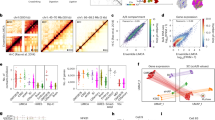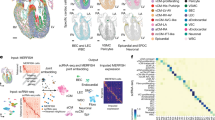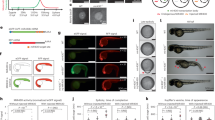Abstract
Transcription factors and chromatin modifiers are important in the programming and reprogramming of cellular states during development1,2. Transcription factors bind to enhancer elements and recruit coactivators and chromatin-modifying enzymes to facilitate transcription initiation3,4. During differentiation a subset of these enhancers must be silenced, but the mechanisms underlying enhancer silencing are poorly understood. Here we show that the histone demethylase lysine-specific demethylase 1 (LSD1; ref. 5), which demethylates histone H3 on Lys 4 or Lys 9 (H3K4/K9), is essential in decommissioning enhancers during the differentiation of mouse embryonic stem cells (ESCs). LSD1 occupies enhancers of active genes that are critical for control of the state of ESCs. However, LSD1 is not essential for the maintenance of ESC identity. Instead, ESCs lacking LSD1 activity fail to differentiate fully, and ESC-specific enhancers fail to undergo the histone demethylation events associated with differentiation. At active enhancers, LSD1 is a component of the NuRD (nucleosome remodelling and histone deacetylase) complex, which contains additional subunits that are necessary for ESC differentiation. We propose that the LSD1–NuRD complex decommissions enhancers of the pluripotency program during differentiation, which is essential for the complete shutdown of the ESC gene expression program and the transition to new cell states.
This is a preview of subscription content, access via your institution
Access options
Subscribe to this journal
Receive 51 print issues and online access
$199.00 per year
only $3.90 per issue
Buy this article
- Purchase on Springer Link
- Instant access to full article PDF
Prices may be subject to local taxes which are calculated during checkout




Similar content being viewed by others
References
Graf, T. & Enver, T. Forcing cells to change lineages. Nature 462, 587–594 (2009)
Young, R. A. Control of the embryonic stem cell state. Cell 144, 940–954 (2011)
Fuda, N. J., Ardehali, M. B. & Lis, J. T. Defining mechanisms that regulate RNA polymerase II transcription in vivo. Nature 461, 186–192 (2009)
Li, B., Carey, M. & Workman, J. L. The role of chromatin during transcription. Cell 128, 707–719 (2007)
Shi, Y. et al. Histone demethylation mediated by the nuclear amine oxidase homolog LSD1. Cell 119, 941–953 (2004)
Wang, J. et al. Opposing LSD1 complexes function in developmental gene activation and repression programmes. Nature 446, 882–887 (2007)
Wang, J. et al. The lysine demethylase LSD1 (KDM1) is required for maintenance of global DNA methylation. Nature Genet. 41, 125–129 (2009)
Foster, C. T. et al. Lysine-specific demethylase 1 regulates the embryonic transcriptome and CoREST stability. Mol. Cell. Biol. 30, 4851–4863 (2010)
Kagey, M. H. et al. Mediator and cohesin connect gene expression and chromatin architecture. Nature 467, 430–435 (2010)
Chen, X. et al. Integration of external signaling pathways with the core transcriptional network in embryonic stem cells. Cell 133, 1106–1117 (2008)
Pardo, M. et al. An expanded Oct4 interaction network: implications for stem cell biology, development, and disease. Cell Stem Cell 6, 382–395 (2010)
van den Berg, D. L. et al. An Oct4-centered protein interaction network in embryonic stem cells. Cell Stem Cell 6, 369–381 (2010)
Niwa, H., Miyazaki, J. & Smith, A. G. Quantitative expression of Oct-3/4 defines differentiation, dedifferentiation or self-renewal of ES cells. Nature Genet. 24, 372–376 (2000)
Rossant, J. & Cross, J. C. Placental development: lessons from mouse mutants. Nature Rev. Genet. 2, 538–548 (2001)
Metzger, E. et al. LSD1 demethylates repressive histone marks to promote androgen-receptor-dependent transcription. Nature 437, 436–439 (2005)
Shi, Y. J. et al. Regulation of LSD1 histone demethylase activity by its associated factors. Mol. Cell 19, 857–864 (2005)
Wang, Y. et al. LSD1 is a subunit of the NuRD complex and targets the metastasis programs in breast cancer. Cell 138, 660–672 (2009)
Liang, J. et al. Nanog and Oct4 associate with unique transcriptional repression complexes in embryonic stem cells. Nature Cell Biol. 10, 731–739 (2008)
Dovey, O. M., Foster, C. T. & Cowley, S. M. Histone deacetylase 1 (HDAC1), but not HDAC2, controls embryonic stem cell differentiation. Proc. Natl Acad. Sci. USA 107, 8242–8247 (2010)
Kaji, K. et al. The NuRD component Mbd3 is required for pluripotency of embryonic stem cells. Nature Cell Biol. 8, 285–292 (2006)
Scimone, M. L., Meisel, J. & Reddien, P. W. The Mi-2-like Smed-CHD4 gene is required for stem cell differentiation in the planarian Schmidtea mediterranea. Development 137, 1231–1241 (2010)
Heintzman, N. D. et al. Distinct and predictive chromatin signatures of transcriptional promoters and enhancers in the human genome. Nature Genet. 39, 311–318 (2007)
Forneris, F., Binda, C., Vanoni, M. A., Battaglioli, E. & Mattevi, A. Human histone demethylase LSD1 reads the histone code. J. Biol. Chem. 280, 41360–41365 (2005)
Lee, M. G. et al. Functional interplay between histone demethylase and deacetylase enzymes. Mol. Cell. Biol. 26, 6395–6402 (2006)
Musri, M. M. et al. Histone demethylase LSD1 regulates adipogenesis. J. Biol. Chem. 285, 30034–30041 (2010)
Choi, J. et al. Histone demethylase LSD1 is required to induce skeletal muscle differentiation by regulating myogenic factors. Biochem. Biophys. Res. Commun. 401, 327–332 (2010)
Okumura-Nakanishi, S., Saito, M., Niwa, H. & Ishikawa, F. Oct-3/4 and Sox2 regulate Oct-3/4 gene in embryonic stem cells. J. Biol. Chem. 280, 5307–5317 (2005)
Yeom, Y. I. et al. Germline regulatory element of Oct-4 specific for the totipotent cycle of embryonal cells. Development 122, 881–894 (1996)
Nakatake, Y. et al. Klf4 cooperates with Oct3/4 and Sox2 to activate the Lefty1 core promoter in embryonic stem cells. Mol. Cell. Biol. 26, 7772–7782 (2006)
Ray, S. et al. Context-dependent function of regulatory elements and a switch in chromatin occupancy between GATA3 and GATA2 regulate Gata2 transcription during trophoblast differentiation. J. Biol. Chem. 284, 4978–4988 (2009)
Acknowledgements
We thank J. Lovén, M. H. Kagey, J. Dowen, A. C. Mullen, A. Sigova, P. B. Rahl, T. Lee and members of Y. Shi’s laboratory for experimental assistance, reagents and helpful discussions; and J.-A. Kwon, V. Dhanapal, J. Love, S. Gupta, T. Volkert, W. Salmon and N. Watson for assistance with ChIP-Seq, expression arrays and immunofluorescence imaging acquisition. This work was supported by a Canadian Institutes of Health Research Fellowship (S.B.), a Career Development Award from the Medical Research Council (S.M.C.), and by National Institutes of Health grants HG002668 and NS055923 (R.Y.).
Author information
Authors and Affiliations
Contributions
W.A.W., S.B., H.A.H., C.T.F., S.M.C and R.A.Y. designed, conducted and interpreted the ChIP-Seq, immunofluorescence and expression experiments. W.A.W., D.A.O. and G.M.F. performed data analysis. The manuscript was written by S.B., W.A.W. D.A.O., H.A.H., G.M.F. and R.A.Y.
Corresponding author
Ethics declarations
Competing interests
The authors declare no competing financial interests.
Supplementary information
Supplementary Figures
This file contains Supplementary Figures 1-13 with legends. (PDF 2530 kb)
Supplementary Information
This file contains a Supplementary Discussion, Supplementary Experimental Procedures (see Contents for more information) and Supplementary References. (PDF 307 kb)
Supplementary Tables 1-5
This zipped file contains the following: Supplementary Table 1- Summary of occupied genes and regions; Supplementary Table 2 - Summary of LSD1 occupancy at active and poised enhancers; Supplementary Table 3 - Gene expression changes 48 hours after Oct4 repression in ZHBTc4 DMSO (control)- and TCP-treated cells; Supplementary Table 4 Genes co-occupied by LSD1 and REST; Supplementary Table 5 - Enhancer decommissioning 48 hours after Oct4 depletion in ZHBTc4 DMSO (control)- and TCP-treated cells. (ZIP 27599 kb)
Supplementary Data 1
This file contains compressed ChIP-Seq data in WIG format for upload into the UCSC genome browser. This file contains data for: mES_CoREST_min1.0.WIG; mES_HDAC1_combn_min1.0.WIG; mES_HDAC2_combn_min1.0.WIG; mES_LSD1_min1.0.WIG; mES_Med1_min1.0.WIG; mES_Mi2(combined)_min1.0.WIG; mES_Nanog_min1.0.WIG; mES_Oct4_min1.0.WIG; mES_p300_min1.0.WIG; mES_Pol2_min1.0.WIG; mES_REST_min1.0.WIG; mES_Sox2_min1.0.WIG; mES_Suz12_min1.0.WIG; mES_TBP_min1.0.WIG; mES_WCE_min1.0.WIG. The first track for each data set contains the ChIP-Seq density across the genome in 25bp bins. The minimum ChIP-Seq density shown in these files is 1.0 reads per million total reads. Subsequent tracks identify genomic regions identified as enriched at a p-value threshold of 10-9. (ZIP 13280 kb)
Supplementary Data 2
This file contains compressed ChIP-Seq data in WIG format for upload into the UCSC genome browser. This file contains data for: mES_H3K36me3_min1.0.WIG; mES_H3K4me1_min1.0.WIG; mES_H3K4me3_min1.0.WIG; mES_H3K79me2_min1.0.WIG. The first track for each data set contains the ChIP-Seq density across the genome in 25bp bins. The minimum ChIP-Seq density shown in these files is 1.0 reads per million total reads. Subsequent tracks identify genomic regions identified as enriched at a p-value threshold of 10-9. (ZIP 16300 kb)
Supplementary Data 3
This file contains compressed ChIP-Seq data in WIG format for upload into the UCSC genome browser. This file contains data for: DMSO_0HR_H3K4me1.WIG; WCE_DMSO_48HR_min1.0.WIG; DMSO_48HR_H3K4me1.WIG; TCP_48HR_H3K4me1.WIG; WCE_TCP_48HR_min1.0.WIG. The first track for each data set contains the ChIP-Seq density across the genome in 25bp bins. The minimum ChIP-Seq density shown in these files is 1.0 normalized read per million total reads. Subsequent tracks identify genomic regions identified as enriched at a p-value threshold of 10-9. (ZIP 13821 kb)
Supplementary Data 4
This file contains compressed ChIP-Seq data in WIG format for upload into the UCSC genome browser. This file contains data for: WCE_DMSO_min1.0.WIG; mES_DMSO_H3K27ac.WIG; mES_DMSO_H3K4me1.WIG; mES_C646_H3K27ac.WIG; mES_C646_H3K4me1.WIG. The first track for each data set contains the ChIP-Seq density across the genome in 25bp bins. The minimum ChIP-Seq density shown in these files is 1.0 reads per million total reads. Subsequent tracks identify genomic regions identified as enriched at a p-value threshold of 10-9. (ZIP 20243 kb)
Rights and permissions
About this article
Cite this article
Whyte, W., Bilodeau, S., Orlando, D. et al. Enhancer decommissioning by LSD1 during embryonic stem cell differentiation. Nature 482, 221–225 (2012). https://doi.org/10.1038/nature10805
Received:
Accepted:
Published:
Issue Date:
DOI: https://doi.org/10.1038/nature10805
This article is cited by
-
Kdm1a safeguards the topological boundaries of PRC2-repressed genes and prevents aging-related euchromatinization in neurons
Nature Communications (2024)
-
H3.3 contributes to chromatin accessibility and transcription factor binding at promoter-proximal regulatory elements in embryonic stem cells
Genome Biology (2023)
-
H3K27me3-H3K4me1 transition at bivalent promoters instructs lineage specification in development
Cell & Bioscience (2023)
-
OVOL2 sustains postnatal thymic epithelial cell identity
Nature Communications (2023)
-
Live-cell three-dimensional single-molecule tracking reveals modulation of enhancer dynamics by NuRD
Nature Structural & Molecular Biology (2023)
Comments
By submitting a comment you agree to abide by our Terms and Community Guidelines. If you find something abusive or that does not comply with our terms or guidelines please flag it as inappropriate.



